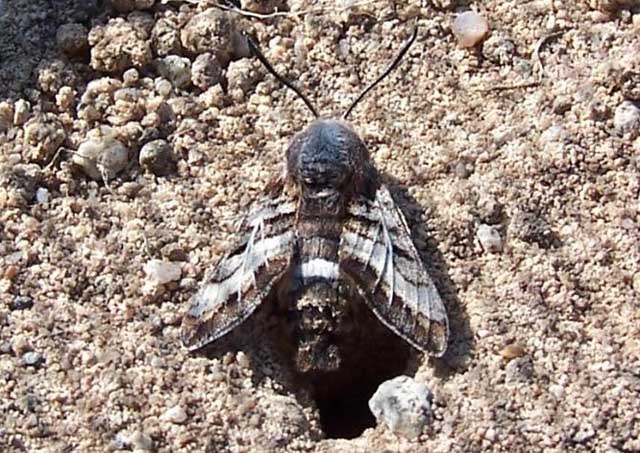Sphinginae subfamily
Sphingini tribe:
 |
This moth is a very strong flier, and make its way to
southern Arizona and southern California.
It is confirmed for Pima County and neighbouring counties.
|
 |
This species is confirmed in Pima County, and
has been seen in nearby counties.
I suspect if you grow tomatoes, you are likely to encounter it.
|
 |
This species is officially recorded in Pima County, and it has been
taken in other nearby counties. Look for three large yellow spots
on each side of the abdomen.
|
 |
This species is recorded in Pima County.
If you grow tomatoes, you have probably encountered it, though.
Larvae get very large and can strip a tomato plant.
|
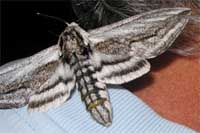 |
This species is recorded in Pima County.
The upperside of the forewing has a wide white band along the costa
from base to apex. The remainder of the wing has black and white
bands.
|
 |
Sphinx chersis
WO/IN,
the Northern Ash Sphinx or Great Ash Sphinx
This species is reported in Pima. Larval hosts are ash,
lilac, privet, cherry, and quaking aspen.
|
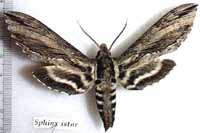 | The upperside of the forewing is dark gray with brown tinges. A
series of narrow dashes runs from the tip to the
cell spots, and a wide black band runs from the middle of the
outer margin to the base of the wing. It flies to the
east and to the south and might be present.
|
Smerinthini Tribe:
 |
This one is quite similar to Pachysphinx modesta, with modesta
being smaller and darker.
Moths should be on the wing from June-August.
|
 |
Smerinthus cerisyi
USGS/ER, the Cerisyi's
Sphinx or One-eyed Sphinx, Larvae feed on poplars and willows.
Flight would be from late May-July as a single brood.
|
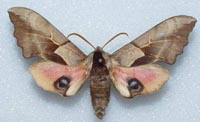 |
Smerinthus saliceti
USGS/IN/ER, the Salicet
Sphinx, flies in valleys and along streamsides from Mexico City north
to west Texas, southern Arizona, and extreme southern California.
Larvae feed on poplars and willows.
Flight would be from late April-September, probably as a double brood.
|
Macroglossinae subfamily
Dilophonotini tribe:
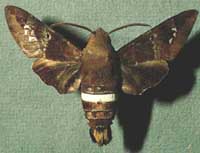 |
The body is dark brown with a wide white
band across the abdomen. Wings are dark brown. The forewing has a
black cell spot and 3 white spots near the pale brown marginal
area. possible stray |
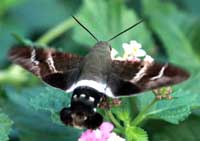 |
The body is dark brown with a wide white stripe across the abdomen.
The wings are dark brown. It is very similar to above species, but the
upperside of the hindwing has
pale patches along the costa and inner margin. possible stray |
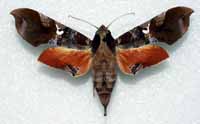 |
This species is reddish, has falcate wings
and flies after midnight. possible stray |
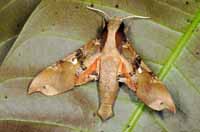 |
This species is easily confused with C. falcifera and
may or
may not be present in Arizona.
See the species file. possible stray |
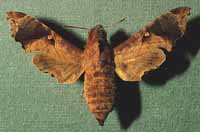
|
Enyo lugubris, the Mournful Sphinx,
USGS
The body and wings are dark brown. The forewing has a large black
patch covering most of the outer half of the wing. There is a pale
tan cell spot (dark inner pupil), and a fairly straight median line
to the inside of the cell spot.
possible stray
|
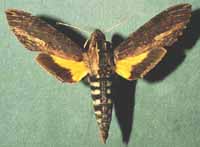
|
The upperside of the forewing is dark brown with short yellowish
streaks on the forward half and wavy yellowish bands on the rear
half.
The upperside of the hindwing is bright yellow with a wide dark brown border.
possible stray
|
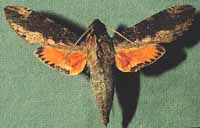 |
The upperside of the abdomen is gray, without black bands, and
the underside does not have black spots. The upperside of the
forewing is dark brown, and may have pale yellow-brown patches
along the inner edge.
|
 |
This species is reported in Pima County and in other southern
Arizona counties.
Males and females differ. rare
|
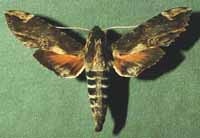 |
This moth flies in Haiti and Jamaica south to Paraguay and Bolivia
with occasional sightings in Texas and Arizona.
possible stray
|
 |
During the night adults nectar at flowers, including bouncing bet
(Saponaria officinalis) and Asystasia gangetica beginning at dusk.
July and August are flight times in the southern states.
|
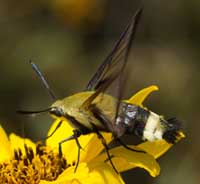 |
Hemaris thetis WO, the Thetis Clearwing or Bee Hawk Moth,
The moth flies along forest edges and in meadows, gardens and
brushy fields. Day-flying adults nectar at lantana, dwarf bush honeysuckle,
snowberry, orange hawkweed, thistles, lilac, Canada violet, etc.
|
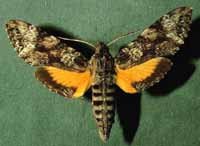 |
Isognathus rimosa, the Rimosus Sphinx,
WO
The upperside of female forewing is mostly gray brown on the front
half and dark brown on the rear half while the upperside of male
forewing is yellow gray or gray brown. Both sexes have wavy dark
markings. The upperside of the hindwing of both sexes is yellow with
an incomplete dark border on the outer margin. possible stray
|
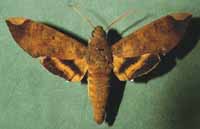 |
Pachylia ficus, the Fig Sphinx,
WO
The upperside of the forewing is orangish brown
with a paler patch along the costa at the tip.
The upperside of
the hindwing is orange to orangish brown with a black outer border, a
black median band, and a white spot on the outer margin near the body.
possible stray
|
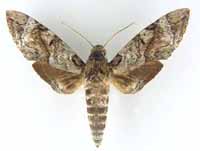 |
The upperside of the forewing is dark brown with a dark spot at the
base of the costa and blurry gray and white markings. The upperside
of the hindwing is dark brown with white along the inner margin, and
the lower half of the outer margin.
possible stray
|
Philampelini tribe:
 |
This moth is officially reported for Pima County.
Eumorpha achemon larvae feed upon Grape (Vitis),
Virginia Creeper (Parthenocissus quinquefolia)
and other vines and ivies (Ampelopsis).
|
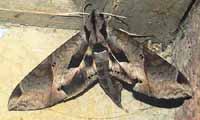 |
The Satellite Sphinx Moth, Eumorpha
satellitia satellitia flies in Jamaica and from Mexico to
Ecuador and further south into Bolivia. stray
|
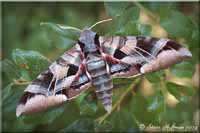 |
The upperside of wings is deep red-brown with pale brown bands. Each hindwing has pink along
the costal margin and a triangular white spot on the outer part of the inner margin.
possible stray
|
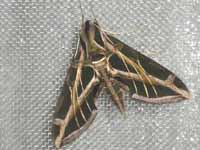 |
The upperside of the moth is dark pinkish brown. Each forewing has a
lighter brown band along the costa, and sharp pinkish white bands and
streaks. The hindwing has a pink patch on the inner margin.
possible stray
|
Macroglossini tribe:
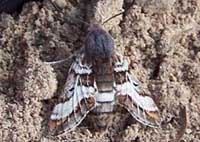 |
Adults nectar at flowers during the warm parts of the day.
Euproserpinus phaeton adults fly swiftly and close to the ground over
dry washes and flat areas in deserts as a single brood from
February-April.
|
 |
Hyles lineata
WO,
the White-lined Sphinx
Adam Fleishman reports many August 11-21 in Tucson, Arizona.
David Bygott sent a larva image in April.
Larvae can be quite varied.
|
|
|
